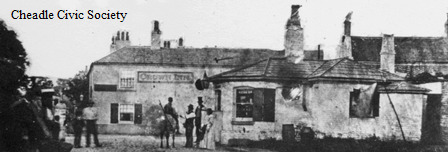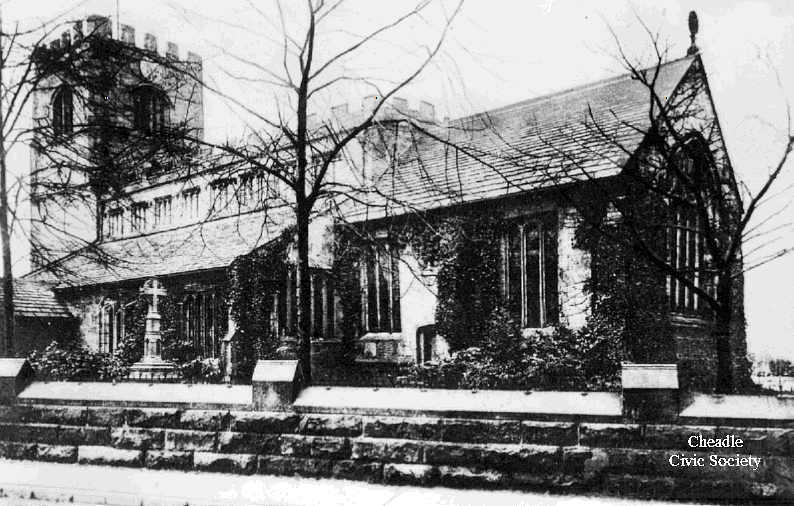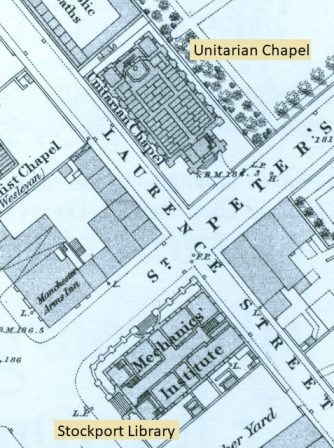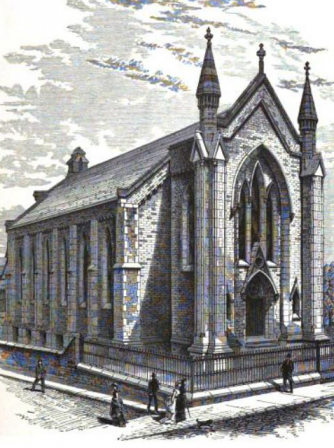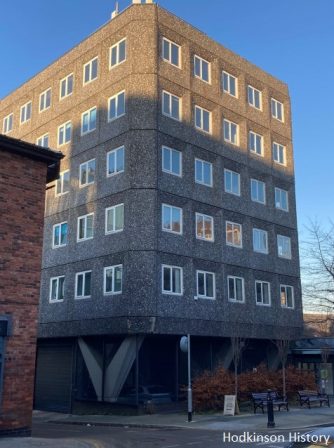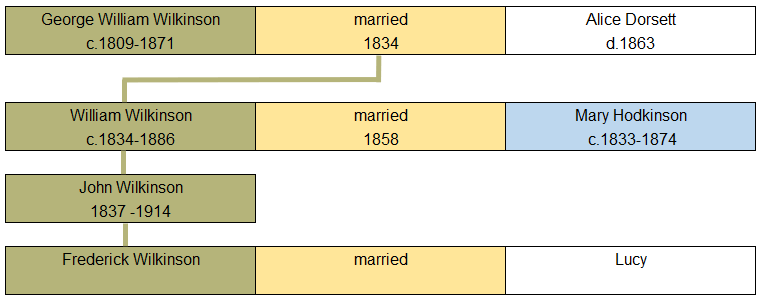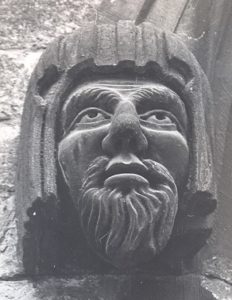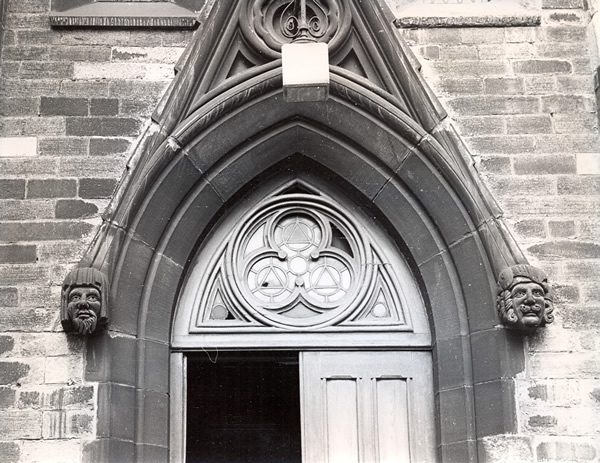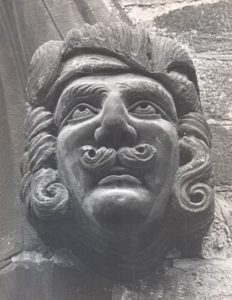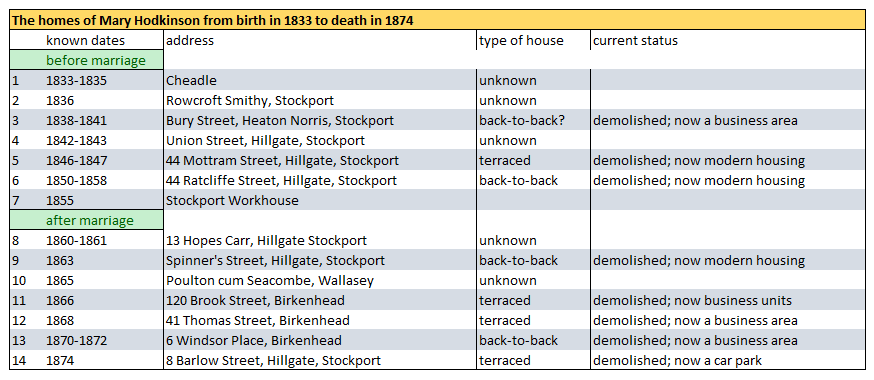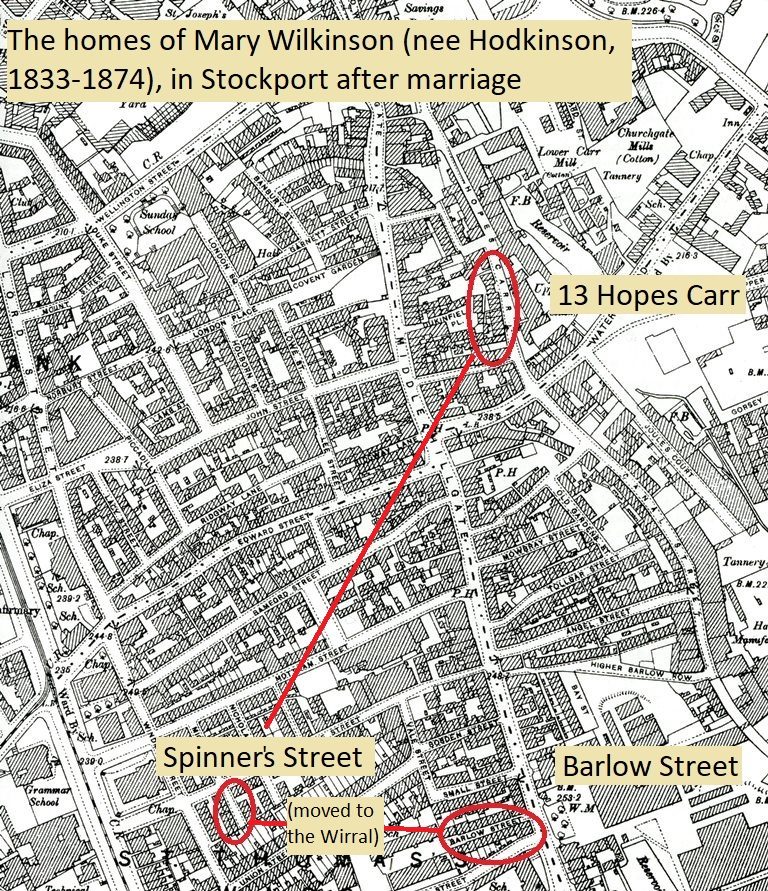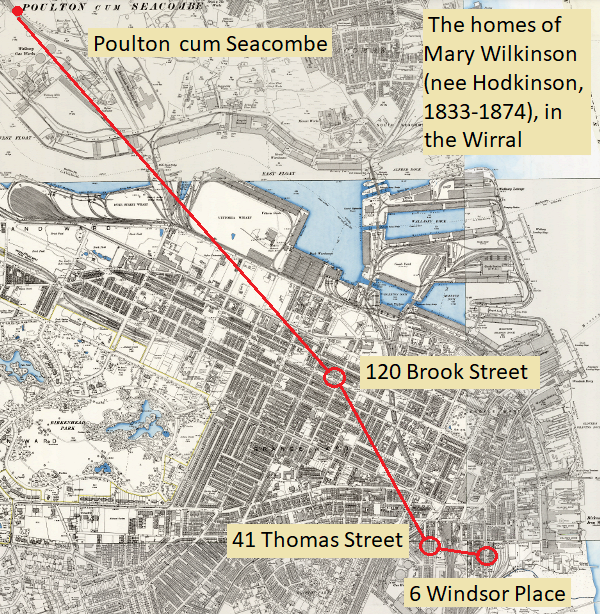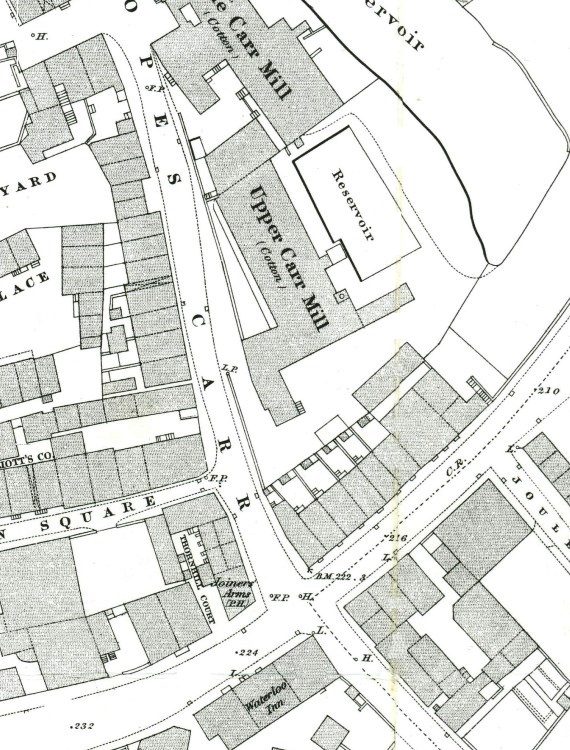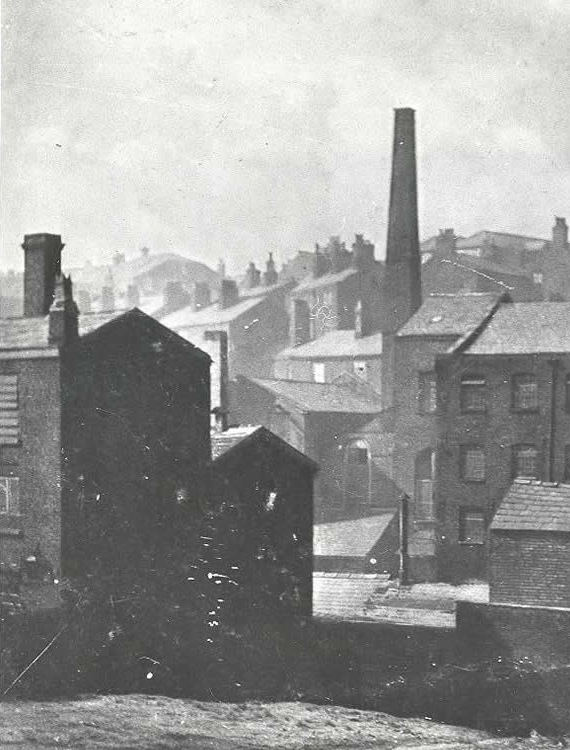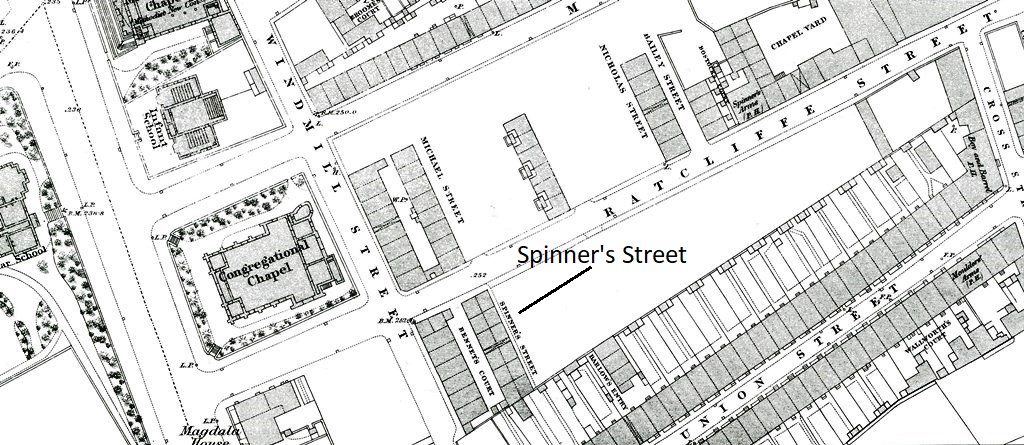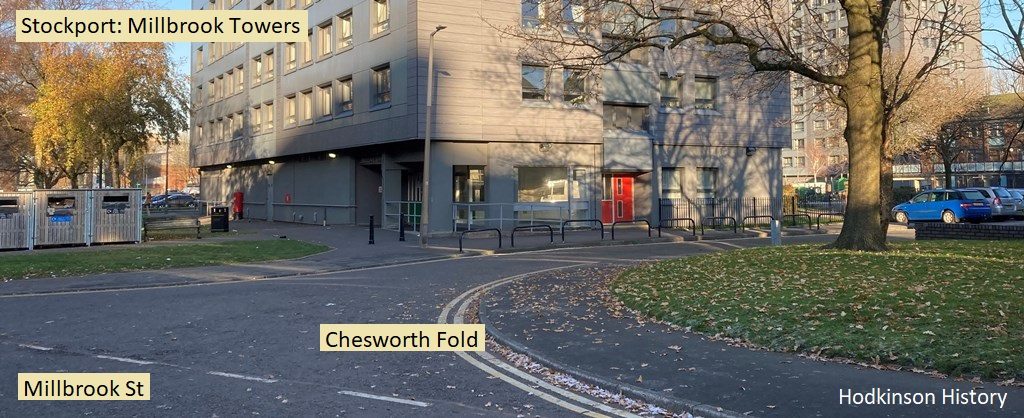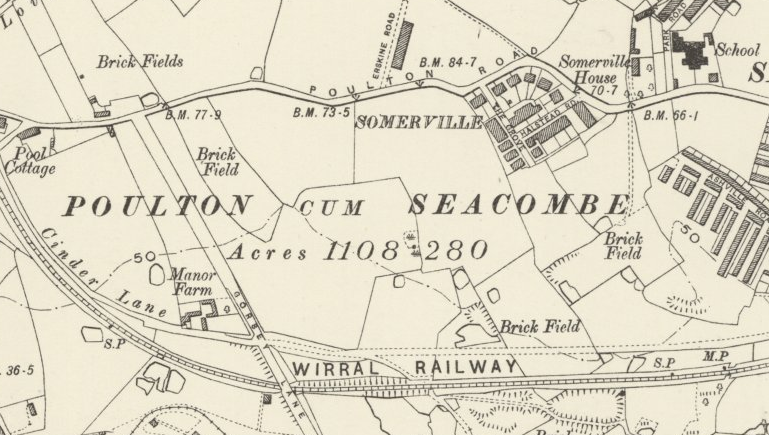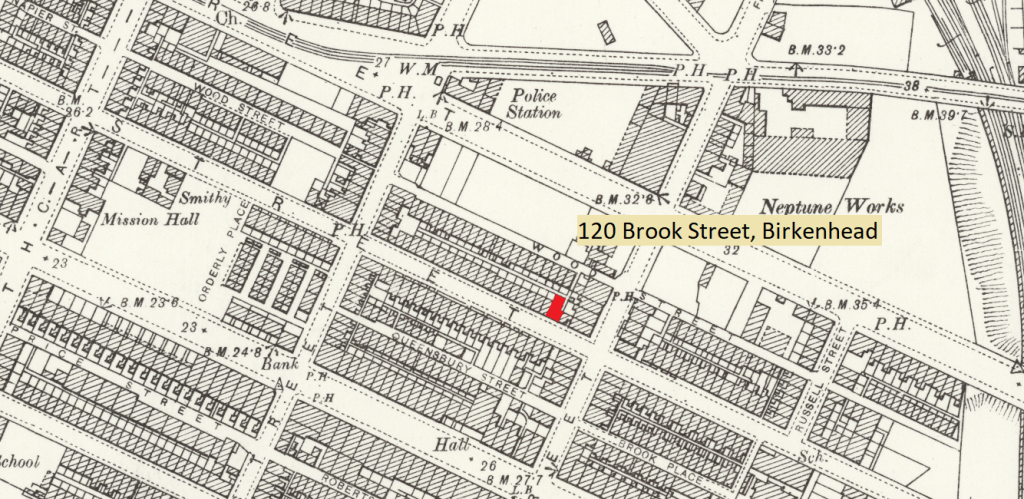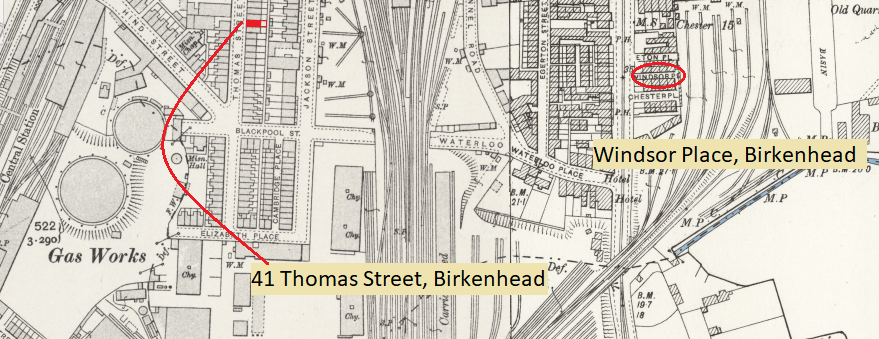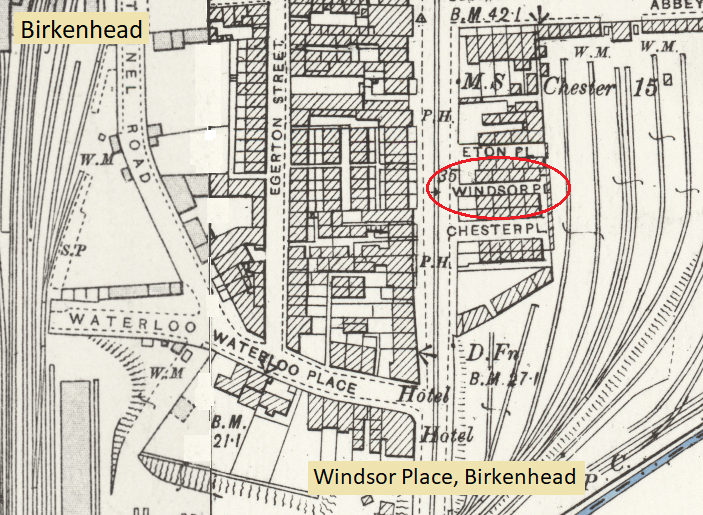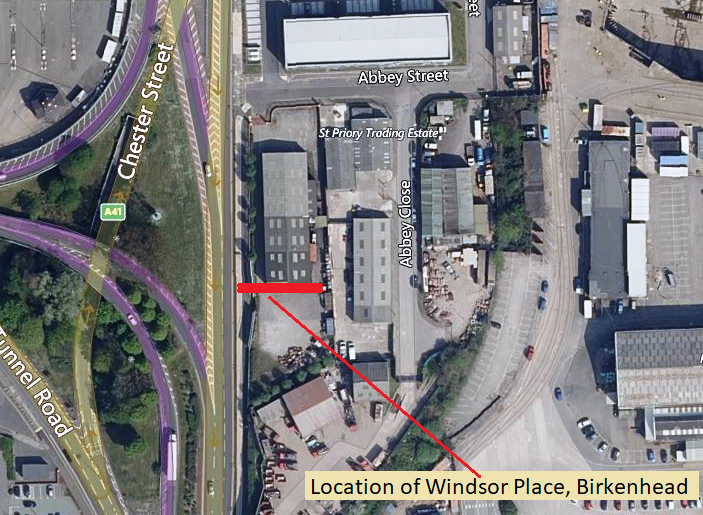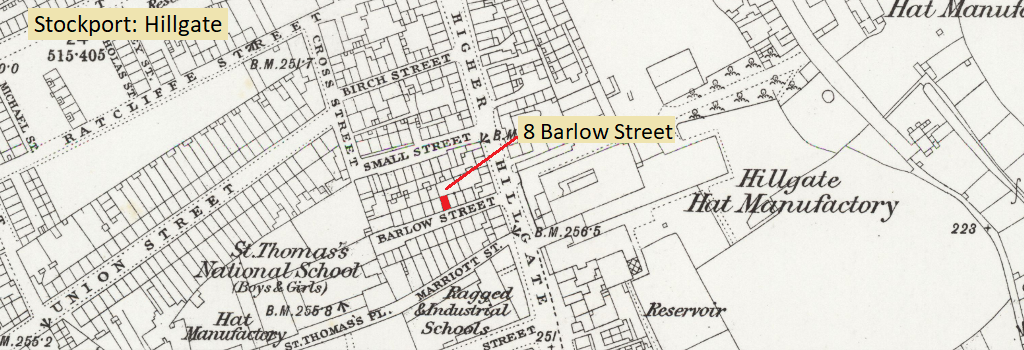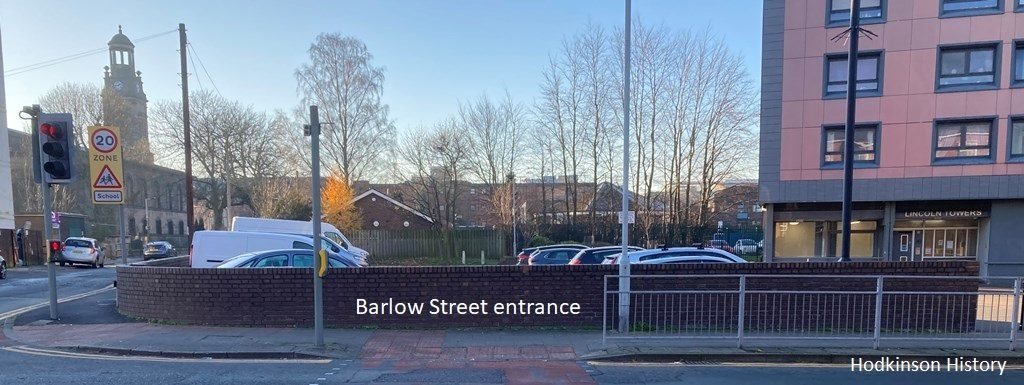Mary Hodkinson: c.1833 to 1874
This page has a little about Mary's baptism, but is mainly about her life from 1855 to her death.
Mary Hodkinson's life before 1855 is to be found as follows:
- the story of Mary Hodkinson from her birth up to 1841 is here; and
- the story of Mary from 1841 to about 1855 is on the webpage which covers the shared history of Mary, Lucy and James Hodkinson.
The image is of the Crown Inn, Cheadle, demolished in 1862. Maybe this was one of the locals frequented by Mary Hodkinson's dad when the Hodkinson family lived in Cheadle in the 1830s. (Photograph: Cheadle Civic Society.2)
Mary Hodkinson's birth, baptism and immediate family
Mary Hodkinson's baptism on Sunday, 7th June 1835
George and Hannah Hodkinson's first child, Mary, was baptised on Sunday, 7th June 1835, in the parish church in Cheadle and it is more than likely that she would have been born in the Cheadle area, bearing in mind that her parents married there in 1832. There is no actual record of her birth, but other records indicate she was born in 1833.
The importance of baptisms in Victorian times can't be understated and, although the ceremonies sometimes took place years after a child's birth, families regarded them as being of huge religious and personal significance; so it was with Mary's baptism. Usually, contemporary church baptismal records state the child's name, the parents' names, occupation of the father, area where the family lived, and the name of the person conducting the ceremony. In Mary's case, Rector Edward Trafford Leigh officiated. He was appointed to his position in 1829 and died in 1847, aged forty-five years.
Mary Hodkinson's road to marriage
Mary Hodkinson's parents married in 1832 in St Mary's Church in Cheadle. Mary was their first child and probably was born in the mid-months of 1833.
In 1834, another marriage at the same church was that of George Wilkinson and Alice Dorsett and their first child was William Wilkinson and was born around 1834.
Move on to 1851 and the Hodkinson and Wilkinson families, who did not know each other, were to be found in Stockport and living within one-third of a mile from each other. Mary Hodkinson and William Wilkinson met (maybe they worked in the same factory or met at church), found out that they were both born in the same town, fell in love, had two children, got married and had eight more children.
Mary Hodkinson's shame – two "out of wedlock" children
Mary first two children were born when she wasn't married. This was shameful and carried a high level of stigma for the mother, but less so for the father. Bearing that in mind, the approach taken by the parents and their families to the birth of the first illegitimate child, John William Hodkinson, was cack-handed. The birth of the second illegitimate child, Mary Wilkinson, was, consequently, dealt with very differently.
John William Hodkinson (born 1855)
The first of Mary's two children born before marriage was John William Hodkinson, with her future husband, William Wilkinson, being the father.
The shame that an illegitimate birth carried with it can't be understated. It was so heavy that often the mother-to-be was disowned by her family, in which case she had only the workhouse to go to for the time before and after the birth of the child. Mary Hodkinson fitted neatly into that kind of framework and her first son, John William Hodkinson, was duly born in the Stockport Union Workhouse on 23rd March 1855.
Yet it is hard to believe her family had disowned her. Her step-dad, William Hodkinson, and her natural mother, Hannah Hodkinson, had three children before they married. Maybe Mary’s parents were being hypocritical, or maybe they felt that they were unable to support her during and after her pregnancy, regardless of the legal status of the baby. Generally, entry to workhouses was voluntary, and – I like to think that this is the case – it may be that Mary herself thought that taking such a route was the best thing to do to ease the burden on her family. Mary would have known her stay in the workhouse would be short which would have helped her decision – but what a tough decision to make!
After leaving the workhouse, the home that Mary Hodkinson returned to, was the family home. This was often the case with women who had given birth to illegitimate children – they were more likely to be living in the workhouse, or with family, than with any man who might be the father.5
Mary Hodkinson resisted pressure by parish officials to name the father of her child and the column on the birth certificate for the father’s name is empty. In the 1861 census, three years after Mary’s marriage to William Wilkinson, John William Hodkinson no longer existed: he was now John Wilkinson with his family status given as the son of William Wilkinson.
Mary Wilkinson (born 1857)
Despite all the problems caused by the "out-of-wedlock" birth of John William Hodkinson, unmarried Mary Hodkinson gave birth to another child, a girl, Mary, on 27th January 1857. Her future husband, William Wilkinson, was again the father.
Having learnt lessons from the birth of John William Hodkinson, a different approach was taken to the birth of the second illegitimate child. The issue was to disguise that an illegitimate birth had taken place at the Hodkinson home at 44 Ratcliffe Street. The solution was quite easy, really – tell the registrar the parents were married and give a false address for the birth.
It was William Hodkinson, Mary’s step-father, who could be a devious chap when he needed to be, who registered the birth and said that the parents were married and that mother Mary Wilkinson’s surname was formerly Hodkinson. It made good sense for the father, William Wilkinson, not to register the birth because he would have to meet the registrar, John Shawcross, face-to face, and perhaps be asked questions about his non-existent marriage by someone who had registered virtually all the births and deaths of the children of William Hodkinson, and so had some knowledge of the family. Doubtless it was William Hodkinson who felt it was best that John Shawcross and William Wilkinson did not meet and was quite willing to be there instead of his 'son-in-law.'
Lies often need more lies to be convincing. This was the case with William Hodkinson who wanted the truth obscured by well-presented falsehoods. In order to make the never-happened marriage more plausible, William Hodkinson, who was living at 44 Ratcliffe Street (Bailey's Court), Stockport, stated that his home was at 68 Ratcliffe Street, and that the new baby was born there. That nicely removed the very crowded Hodkinson home at no. 44 from any connection with the birth. Lying about an address was nothing new to William Hodkinson – after all, he had lied about his address to church officials and the registrar when he married Hannah Hodkinson in a successful attempt to cover up that he had been "living in sin" for many years.
Sadly, William Hodkinson died a few months before his step-daughter’s actual marriage. He may have been devious, but he had his family’s interests at heart.
The December 1858 marriage of Mary Hodkinson and William Wilkinson
A Hodkinson Unitarian marriage
At last! They got around to marrying! It would mean the lies and deceit of Hodkinson and Wilkinson family members – ironically made necessary by Victorian "values" – would come to an end. The wedding of Mary Hodkinson and William Wilkinson took place on 5th December 1858, in the Unitarian Church (a place of worship from 1842 to 1973), St Peter’s Square, Stockport.
Mary Hodkinson and William Wilkinson married at the Unitarian Church, St Peter's Square, Stockport.6 The church was founded in 1841, opened in 1842, closed in 1973, and was subsequently demolished. Its site now has a chunky office block called Petersgate House. (Photograph: Samuel Hodkinson.)
One of the key beliefs of the Unitarians was that God was one (different from the orthodox Christian view that God was the Father, the Son and the Holy Ghost) – hence the name "Unitarian". Unitarianism had evolved from English Presbyterianism which explains why their marriage certificate states the ceremony took place in the Unitarian Church according to "the Rites and Ceremonies of the English Presbyterians". Unitarianism, however, was more than that. “Unitarianism was a gathering place for the spiritually curious, homeless, or persecuted”, writes Zastoupil who goes on to comment how the Unitarians were proud of the heterogeneous nature of their congregations and of the diversity of opinion which could be found.7
William and Mary would have found the liberal outlook appealing. They belonged to a minority: unmarried adults who had children. Sometimes, some communities were less judgemental than others, but, having children ‘out of wedlock’ was generally regarded as shameful and carried a high level of stigma – and much more for the female than the male.
Mary and William must have felt relief at having their wedding in a Unitarian Church, for it was there that they would have found a level of acceptance from those who knew their shameful semi-secret, a level of acceptance which was unlikely to be found in other Christian churches.
However, Unitarians were a very small and unpopular minority faith. The 1851 census indicates there were only 50,000 Unitarians in England and Wales, representing 0.2% of the total population. Unitarianism had been illegal until 1813 but the dislike, distrust and complaints of heresy levelled against the faith continued for many years afterwards.
Mary Hodkinson's wedding: key people
The eight people who are named on Mary's marriage certificate are below.
William Wilkinson: groom
On the marriage certificate, William’s age is stated to be 24. His "rank or profession" is given as "stoker in a factory" which contrasts with his stated occupation on the 1857 birth certificate of his first daughter as "blacksmith’s labourer". His address – 1 Hope’s Carr – was his pre- marriage address. In 1860, the birth certificate for William’s second son, Thyry, gives 13 Hope’s Carr as the birthplace and it is fair to say that the married couple moved to this address after their wedding.
Unlike the bride and the two witnesses, William Wilkinson signed his own name on the marriage certificate. William’s ability to write, and therefore read at even an elementary level, meant that there was a guarantee that the Hodkinson surname would be spelt correctly on the marriage certificate.
George Wilkinson: the groom’s father
William Wilkinson’s father was George Wilkinson who doubtless was at the wedding. He was born in about 1809 and married Alice Dorsett in 1834. In 1863, William Wilkinson’s second daughter was named Alice Dorsett Wilkinson.
George Wilkinson’s work as an "overlooker of power looms" carried with it a great deal of responsibility and accordingly was well paid. He died in 1871, just three years before the death of his daughter-in-law.
John Wilkinson: witness
John Wilkinson was one of the two witnesses to the wedding. He was William Wilkinson’s brother, born in 1837. He signed his name with a cross.
When Mary married, she gained two parents-in-law and at least two brothers-in-law, as can be seen on the patchy and scope-limited Wilkinson family tree below.
Since the main thrust of this website is my Hodkinson family, I spent only a tiny amount of time researching the Wilkinson family – hence the limited tree with limited information. There are more comprehensive Wilkinson family trees on some genealogical sites, with some more accurate than others.
Mary Hodkinson: bride
Mary Hodkinson’s date of birth is not known, but her marriage and death certificates and census returns indicate that she was born in 1833, two years or so before her baptism. Her address is given as 44 Ratcliffe Street which had been the Hodkinson family home for eight years. As seen above, Mary had two children before her marriage, one born in the workhouse in Stockport and the other at the Hodkinsons' family home. The marriage meant that the two children and their father and mother would finally be living together as a family. She signed her name on the marriage certificate with a cross.
George Hodkinson: the bride’s father
George Hodkinson was Mary’s father, but her memory of him would have faded. He left the family home after the affair between his wife, Hannah, and their lodger, William Hodkinson, became known in 1841 when Mary was eight. He died in 1847.
Her step-father, William Hodkinson, died five months before her wedding which meant that neither father nor step-father was alive to see their first (step-) child get married.
Every time Mary Hodkinson and William Wilkinson went to worship at the Unitarian Church, they were greeted at the entrance by these two carved pieces of stone, known as headstops. The position of their eyes (looking towards heaven?) meant there was no eye contact between them and worshippers! (Photograph: acknowledgement to Stockport Metropolitan Borough Council Image Archive.8)
Lucy Hodkinson: witness
Lucy Hodkinson was Mary’s sister and was born in 1836. She signed her name on the marriage certificate with a cross. Lucy married twice – once in 1860 and again in 1866, and on both occasions again signed her name with a cross. Learning to write her name can’t have ever been a priority! Lucy and Mary were very close to each other and would eventually share a house, with their families, in Birkenhead.
Henry Coppock
The marriage certificate has the names of two people who had official roles: Henry Coppock and Richard Mann.
At the time of the marriage of Mary Hodkinson and William Wilkinson, the minister at the Unitarian church was Andrew Macreight Creery. The marriage, however, was solemnized by Henry Coppock, (1806-1870), a Superintendent Registrar and a key figure in Unitarianism in Stockport.
Henry Coppock was eulogised after his death on a plaque within the church for his character and his Unitarian faith. As a contrast, on an earlier occasion, the (anti-Unitarian?) Stockport Advertiser described him as a violent party man.
Henry Coppock held important local positions and was a wealthy individual. The 1861 census indicates that he was living with his wife and nine children and five servants in Daw Bank House, Stockport – a grand house, with good-sized grounds, with a lodge and lodge keeper.
Richard Mann
Although the marriage ceremony was duly solemnised by Henry Coppock, it was a nonconformist marriage and, as such under the Marriage Act of 1836, it would not have been legal unless a local government registrar was present. That role was filled by 57-year-old Richard Mann who at the time of Mary Hodkinson’s marriage was living with his wife and two children in Hall Street, Stockport, not that far away from the homes of the bride and groom.
The ten children of Mary Wilkinson (Hodkinson)
Mary Hodkinson and William Wilkinson had ten children. The ten-yearly census returns provide details of some of them, but when children are born and die between census returns, they are often missed from family trees. This is true of Wilkinson family trees on Ancestry on which can be found some of the Wilkinsons mentioned on this page, with the exception of most of the children. The information below is, then, ripe for plagiarism by Wilkinson family researchers!
John William Hodkinson was born in 1855 in the workhouse in Stockport, three years before his parents married. His surname was quasi-officially changed, quietly and discretely, simply by stating his surname to be Wilkinson in the 1861 census. His own marriage, which took place in 1876 in St Mary’s Church in Stockport, was to Priscilla Jones Gee. He died in 1915 from pneumonia.
Another John William Hodkinson is in the family history. He was born in 1869, the nephew of Mary, and the second son of her brother James Hodkinson.
Mary Wilkinson was born in 1857 in Stockport and named as Mary Wilkinson on her birth certificate, even though her parents had not yet married.
Thyry Wilkinson was the first child born after Mary Hodkinson and William Wilkinson married. His first name is exceptionally unusual. A search on Ancestry reveals a small number of others who had Thyry as a first name or surname in Victorian times but they did not live in the British Isles. Thyry, sadly, died in 1861 just a few weeks before his first birthday. In terms of unusual first names, it is worth mentioning that there was also a Thyrya Mathews from Somerset who died in about 1862.
Alice Dorsett Wilkinson was born in 1863 in Spinner's Street in Stockport. Her first two names are the first name and surname of her paternal grandmother.
Between 1865 and 1871, Mary had five children born in Wallasey or Birkenhead. Four of them – John Wilkinson, Priscilla Dawsett9 Wilkinson, Alfred Wilkinson and Fred Wilkinson – all died aged between one day and one month. It was left to Ann Harris, one of Mary’s friends, to report the deaths of Alfred and Fred (good name choices!) to Alex Blaylock, the local Registrar; maybe Mary just could not face doing that emotionally draining task. Out of the five children born between 1865 and 1871, George Wilkinson was the only one who survived to become an adult.
Hannah Wilkinson was the last child born to Mary and William. She born in late 1872 in Windsor Place, Birkenhead. By then, her mother was 39, her father was about 37 and her oldest brother, John William, was about 17 years old. She was most likely named after her maternal grandmother, Hannah Hodkinson.
Two Hodkinson sisters in Birkenhead
The Hodkinson family living at 44 Ratcliffe Street, Stockport, started to split up from the late 1850s as the children grew up and left home. Mary Wilkinson (Hodkinson), who moved out of the Hodkinson family home after her wedding in 1858 to a new marital home in Stockport, was living in Birkenhead by 1865 with the rest of her family. Her sister, Lucy Hodkinson (Newton from 1866), who was born in 1836, also moved to Birkenhead sometime between 1867 and 1869.
Undoubtedly, the spur to move for both the Wilkinsons and Newtons centred on finding work in its own right, or finding work that paid a better wage. Stockport had not grown economically since the 1840s, but the years from 1861-1865 were particularly bad, when a severe economic downturn had a devastating impact on employment. Both families may have decided together what the solution was – to leave Stockport completely and start new lives in Birkenhead. William Wilkinson found work as a labourer in a shipyard, but was to eventually get better pay as a (stationary) engine driver.
Interestingly, the Wilkinsons and the Newtons even shared the same home at 6 Windsor Place, Birkenhead. The house, unfortunately, was at the lower end of working-class housing. It was a back-to-back house, in a dirty, unhygienic and densely populated area, with heavy industry and extensive railway operations contributing to a noisy and polluting and bleak, dispiriting environment. (See maps further down this page.) It is not surprising that two of Mary’s children died at this address shortly after their births.
There had to be a better life somewhere else. Lucy and her family certainly thought so, talked about what to do, and made a momentous decision, the result of which was that the family landed on Australian soil on 21st July 1870. It’s inconceivable that Mary Wilkinson and her family were not involved in the discussions about emigrating – it’s a shame that the reasons why they didn’t also emigrate will never be known. With the departure of the Newtons to Australia, both families would have felt a deep sense of loss; the chances of seeing each other again were virtually non-existent and the reality is that they never did. To make matters worse for the Wilkinsons, bearing in mind that the Newtons had emigrated for a new start in a distant land, they, the Wilkinsons, knew their future offered nothing different to what they had experienced for decades.
The death of Mary Wilkinson (Hodkinson) in 1874
Eventually, the Wilkinsons had had enough of Birkenhead. The one place that they really knew was Stockport and so, sometime between 1872 and 1874, they headed back to familiar territory. In fact, the territory was very familiar: they moved into 8 Barlow Street, Hillgate, which was a 250-yard walk to Mary’s old family home on Ratcliffe Street and 500 yards to her first marital home on Hopes Carr.
At the end of August 1874, Mary Wilkinson developed erysipelas, an infection of the tissues under the skin, which usually results from contamination from a break in the skin and is characterised by acute localised inflammation and oedema. Unfortunately for Mary, one of the complications of erysipelas — pneumonia – set in. The two diseases led to her death on Sunday, 6th September 1874 with her husband, William Wilkinson, present. She was 41 years old.
The homes of Mary Wilkinson (Hodkinson)
A list of known homes and their known dates
The known dates of Mary's known homes are stated below. Mary would have lived at some of these addresses for much longer than the date(s) given. Additionally, she may have lived at other addresses but, if that is the case, the locations are unknown.
Before marriage, Mary Wilkinson lived in at least seven different homes, including time spent in the workhouse in Stockport. There is more about these addresses here and here.
After marriage, Mary Wilkinson lived in at least seven different homes – two in Stockport, four on the Wirral and then another in Stockport when she returned to the town. More about these addresses follows below.
The homes of Mary Wilkinson (Hodkinson), after marriage
Maps showing the locations of Mary Wilkinson's homes, by area
This map shows the location of the Wilkinsons' homes in Stockport. The family lived in Hope's Carr and Spinner's Street before moving to the Wirral and then back to Stockport, to Barlow Street, where Mary died.
When Mary Wilkinson and her family moved to the Wirral, they lived in at least four locations: the first was Poulton cum Seacombe; next was 120 Brook Street, Birkenhead; then 41 Thomas Street, Birkenhead; and, finally, 6 Windsor Place, Birkenhead. The family then moved to Barlow Street, Stockport (see Stockport map above).
Mary Wilkinson's homes, after marriage, in chronological order
The map is from 1873 and shows the lower part of Hopes Carr, Stockport. The 1851 census lists houses numbered from 1 to 23 (from 2 to 24 in the 1871 census), which were on the west side of the street. William Wilkinson lived at 1 Hopes Carr before marriage and at 13 afterwards. The photograph is from the early years of the 20th century and is a south-westerly view of Hopes Carr, as seen from Orchard Street. (Photograph: acknowledgement to Stockport Metropolitan Borough Council Image Archive.10)
The Wilkinson family lived at 13 Hopes Carr from at least 1860 to at least 1861. Those who lived at this address for some or all of the time stated were:
- Mary Wilkinson (born 1833, nee Hodkinson), wife of William Wilkinson;
- William Wilkinson (born about 1834), husband of Mary Wilkinson (nee Hodkinson);
- John William Wilkinson (registered as Hodkinson at birth), first son of unmarried Mary Hodkinson and William Wilkinson;
- Mary Wilkinson, first daughter of unmarried Mary Hodkinson and William Wilkinson; and
- Thyry Wilkinson, second son of Mary Wilkinson and William Wilkinson who, by the time of Thyry's birth, were married.
Spinner's Street, Hillgate, Stockport
This is an extract from an Ordnance Survey map which was surveyed in 1849 and revised in 1873. At that point, only one side of Spinner's Street had been built. All the open areas, as seen on the map, would eventually disappear as more buildings were crammed into whatever space was available. Spinner's Street no longer exists, but there is a modern Spinner (not Spinner's) Street, about half a mile to the north east of its earlier version.
What happened to Spinner's Street? The middle of the street ran, in very approximate terms, from the red fire sign on the front of Mottram Towers, underneath the tower and across Chesworth Fold to the small wall seen on the right of the image. (Photograph: Samuel Hodkinson.)
The Wilkinson family lived on Spinner's Street, Hillgate, for at least some of 1863.
Those who lived here for some or all of the date above were:
- Mary Wilkinson (born 1833, nee Hodkinson), wife of William Wilkinson;
- William Wilkinson (born about 1834), husband of Mary Wilkinson (nee Hodkinson);
- John William Wilkinson (registered as Hodkinson at birth), first son of unmarried Mary Hodkinson and William Wilkinson;
- Mary Wilkinson, first daughter of unmarried Mary Hodkinson and William Wilkinson; and
- Alice Dorsett Wilkinson, second daughter of Mary Wilkinson and William Wilkinson.
William Wilkinson's mother, Alice Wilkinson (born Dorsett), died on 27th August 1863. Six days before that sad event, Mary Wilkinson gave birth to a girl and the decision was made to call her Alice Dorsett Wilkinson following her grandmother's death.
Poulton cum Seacombe, Wallasey
The first reference to the Wilkinson family living in The Wirral, after their move from Stockport, is on their son John Wilkinson's 1865 birth certificate. Unfortunately, the certificate simply states the place of birth as Poulton cum Seacombe, with no further information. Fourteen years earlier, a Board of Health report was scathing in condemning conditions in Seacombe – when compared to towns of a comparable size, the report stated that Seacombe was the filthiest in England, ravaged by fever and cholera.
The Wilkinsons lived in Poulton cum Seacombe for at least some of 1865. Those who lived in this place for some or all of this time were:
- Mary Wilkinson (born 1833, nee Hodkinson), wife of William Wilkinson;
- William Wilkinson (born about 1834), husband of Mary Wilkinson (nee Hodkinson);
- John William Wilkinson (registered as Hodkinson at birth), first son of unmarried Mary Hodkinson and William Wilkinson;
- Mary Wilkinson, first daughter of unmarried Mary Hodkinson and William Wilkinson;
- Alice Dorsett Wilkinson, second daughter of Mary Wilkinson and William Wilkinson; and
- John Wilkinson, third son of Mary Wilkinson and William Wilkinson.
120 Brook Street, Birkenhead
This is an extract from an Ordnance Survey map which was surveyed in 1874 and revised in 1908-1909. The Wilkinsons lived at 120 Brook Street, Birkenhead, for at least some of 1866.
The Wilkinsons lived at 120 Brook Street, Birkenhead, for at least some of 1866. Those who lived here were:
- Mary Wilkinson (born 1833, nee Hodkinson), wife of William Wilkinson;
- William Wilkinson (born about 1834), husband of Mary Wilkinson (nee Hodkinson);
- John William Wilkinson (registered as Hodkinson at birth), first son of unmarried Mary Hodkinson and William Wilkinson;
- Mary Wilkinson, first daughter of unmarried Mary Hodkinson and William Wilkinson;
- Alice Dorsett Wilkinson, second daughter of Mary Wilkinson and William Wilkinson; and
- Priscilla Dorsett Wilkinson, third daughter of Mary Wilkinson and William Wilkinson.
41 Thomas Street, Birkenhead
Having left Brook Street, the Wilkinsons moved to 41 Thomas Street and then to 6 Windsor Place (see below).
The Wilkinsons lived at 41 Thomas Street, Birkenhead, for at least some of 1868. Those who lived here were:
- Mary Wilkinson (born 1833, nee Hodkinson), wife of William Wilkinson;
- William Wilkinson (born about 1834), husband of Mary Wilkinson (nee Hodkinson);
- John William Wilkinson (registered as Hodkinson at birth), first son of unmarried Mary Hodkinson and William Wilkinson;
- Mary Wilkinson, first daughter of unmarried Mary Hodkinson and William Wilkinson;
- Alice Dorsett Wilkinson, second daughter of Mary Wilkinson and William Wilkinson; and
- George Wilkinson, fourth son of Mary Wilkinson and William Wilkinson.
6 Windsor Place, Birkenhead
The last known address of the Wilkinsons (as a family) in Birkenhead was 6 Windsor Place.
The Wilkinsons lived at 6 Windsor Place, Birkenhead, for at least 1870-1872. The family for some or all of this time was comprised of:
- Mary Wilkinson (born 1833, nee Hodkinson), wife of William Wilkinson;
- William Wilkinson (born about 1834), husband of Mary Wilkinson (nee Hodkinson);
- John William Wilkinson (registered as Hodkinson at birth), first son of unmarried Mary Hodkinson and William Wilkinson;
- Mary Wilkinson, first daughter of unmarried Mary Hodkinson and William Wilkinson;
- Alice Dorsett Wilkinson, second daughter of Mary Wilkinson and William Wilkinson;
- George Wilkinson, fourth son of Mary Wilkinson and William Wilkinson;
- Alfred Wilkinson, fifth son of Mary Wilkinson and William Wilkinson:
- Fred Wilkinson, sixth son of Mary Wilkinson and William Wilkinson: and
- Hannah Wilkinson, fourth daughter and the last child of Mary Wilkinson and William Wilkinson.
Additionally, Mary Wilkinson's sister, Lucy Newton, and her family lived in the same house for an unknown period of time. They were:
- Lucy Newton (Hodkinson), wife of William Henry Newton;
- William Henry Newton, husband of Lucy Newton (Hodkinson);
- James Newton, first son of Lucy and William Henry Newton; and
- William Henry Newton, second son of Lucy and William Henry Newton.
Did the two families ever live in the same house at the same time? Probably. What is certain is that the Newtons lived there from at least September 1869 (date on a Newton birth certificate) to about April 1870, when they emigrated to Australia. What is also certain is that the Wilkinsons lived in the same house from July 1870 (date on a Wilkinson birth certificate) to November 1872 (date on another Wilkinson birth certificate). Did the Wilkinsons move into the Newtons' home when the latter left for Australia? How likely was that? Or had the families been sharing the home before the Newtons emigrated? Without going into the whys and wherefores, I think that the two families shared the same house up to the time that the Newtons left for Australia and that is the assumption I've used when writing about the life of Lucy Newton (Hodkinson) elsewhere on this website.
8 Barlow Street, Stockport
8 Barlow Street, Stockport is where Mary Wilkinson died in September 1874. Her husband, William, was present at her death.
Barlow Street (later renamed as Leek Street) no longer exists, with most of it now a car park. The pedestrian crossing on Higher Hillgate, as seen in the image below, lines up quite nicely with the location of the entrance to Barlow Street. The Hodkinsons' family church for many years – St Thomas' – is in the background, once dominating the local area. Tower blocks now do that, including Lincoln Towers which is on the right of the photograph. Mary Wilkinson died at 8 Barlow Street in 1874. (Photograph: Samuel Hodkinson.)
When Mary died, these were the surviving children in the family:
- John William Wilkinson (registered as Hodkinson at birth), first son of unmarried Mary Hodkinson and William Wilkinson;
- Mary Wilkinson, first daughter of unmarried Mary Hodkinson and William Wilkinson;
- Alice Dorsett Wilkinson, second daughter of Mary Wilkinson and William Wilkinson;
- George Wilkinson, fourth son of Mary Wilkinson and William Wilkinson; and
- Hannah Wilkinson, fourth daughter and the tenth and last child of Mary Wilkinson and William Wilkinson.
Probably the youngest three children (Alice, George and Hannah) were living with their parents when their mother died. The two oldest, John William and Mary, were 19 and 17 respectively. Were they still living at 8 Barlow Street?
The Wilkinsons after Mary Wilkinson's death
It was not unusual for widowers to remarry quite soon after the death of a spouse, especially where there were children to care for – a woman's job, after all! William did not take that route, but the death of his wife left him with a huge problem. His eldest two children were old enough to look after themselves, but provision had to be made for Alice (10), George (6) and Hannah (22 months). The choices were that his eldest daughter, Mary, could look after them; or he could get relatives or friends to help; or, somehow, he could look after them himself in addition to working; or he could try a combination of these choices. What course of action he took is not known, but maybe what he did is reflected in the location of the three youngest children in 1881. The census of that year shows that William was again living in Birkenhead but with only one of his children – Hannah. The next two youngest, Alice and George, were living in Uncle Frederick Wilkinson's home in Marple, Cheshire.
The focus of the research on Mary Hodkinson has been her life. It would have been really interesting to find out more about her children, but there are other Hodkinsons who need some attention!
Notes and sources for this page:
- Unless otherwise mentioned, this page is based on copies of birth, marriage and death certificates; census returns; and family documents and related items including photographs which are the property of Samuel Hodkinson.
- Cheadle Civic Society, Cheadle Photographs. (http://www.cheadlephotos.net/contents/en-uk/d14_1860s.html. Accessed 9 May 2021.) Image 598.
- Cheadle Civic Society, Cheadle Photographs. (http://www.cheadlephotos.net/contents/en-uk/d3_1890s.html. Accessed 9 May 2021.) Image 489.
- Henry Heginbotham, Stockport: Ancient and Modern. (London: Sampson Low, Marston and Company. 1892.) Vol. II. p.227.
- Rebecca Probert, Living in sin: unmarried relationships in Victorian Britain. (https://www.historyextra.com/period/victorian/living-in-sin-unmarried-relationships-in-victorian-britain. 2016. Accessed 10 May 2021).
- Henry Heginbotham, Stockport: Ancient and Modern. (London: Sampson Low, Marston and Company. 1892.) Illustration between p. 54 and p.55.
- Lynn Zastoupil, Rammohun Roy and the Making of Victorian Britain. (New York: Palgrave Macmillan. 2010.) p.10.
- Stockport Metropolitan Borough Council, Stockport Image Archive. (http://www.stockport.gov.uk/services/leisureculture/libraries/libraryonline/stockportimagearchive. Accessed 2 December 2020.) Image 11933.
- William Wilkinson’s mother was Alice Dorsett. Her surname became the middle name for Alice Dorsett Wilkinson, born 1863. It also became the middle name for Priscilla Wilkinson, but was spelt Dawsett on her birth certificate and Dorset on her death certificate.
- Stockport Metropolitan Borough Council, Stockport Image Archive. (http://www.stockport.gov.uk/services/leisureculture/libraries/libraryonline/stockportimagearchive. Accessed 2 December 2020.) Image 17995.
This page was originally published on 15th June 2021, with lots of updates completed by Coronation Day, 6th May 2023. Latest updates were finished on 25th May 2024.

